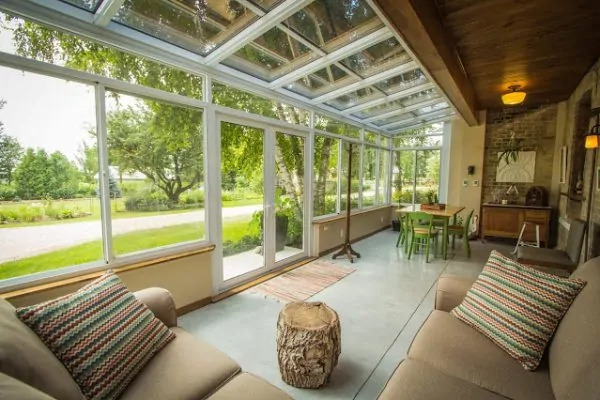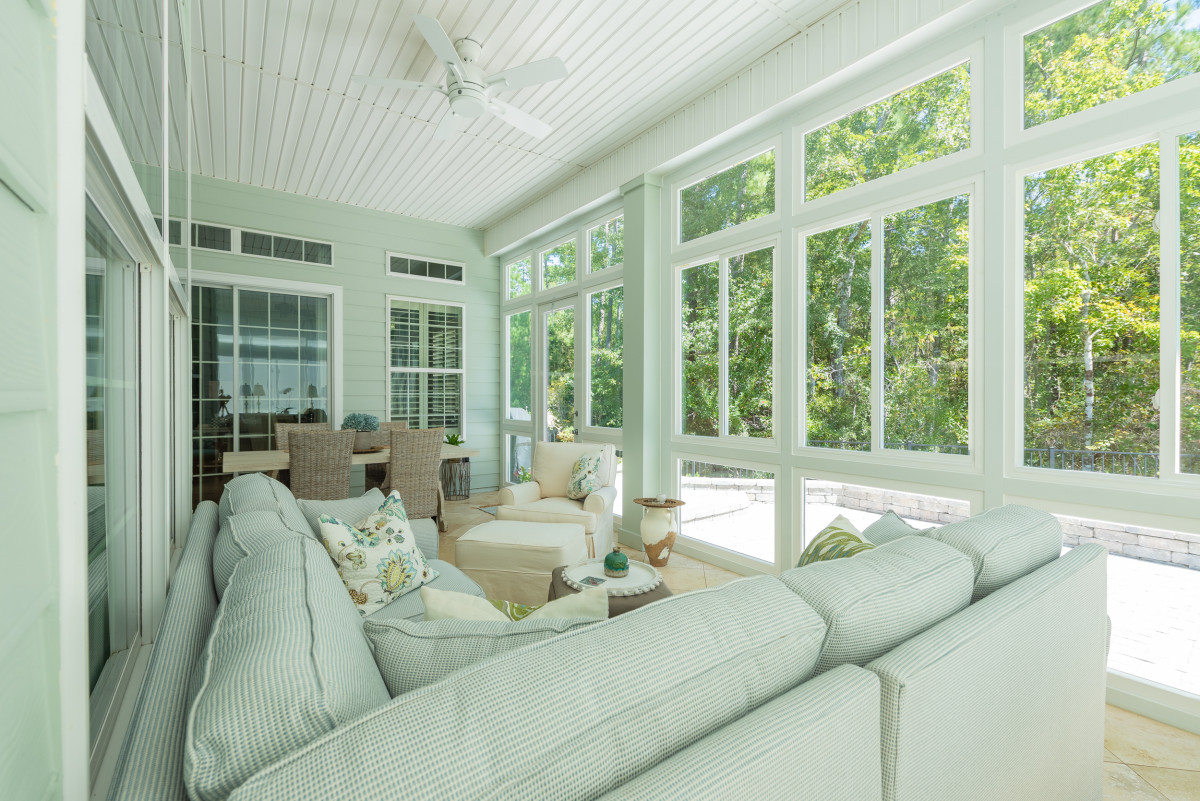Imagine stepping into the beauty of the outdoors merged seamlessly with the comfort of your living room—where the golden rays of dawn welcome you, minus the unwelcome sneeze-triggering pollen. This isn’t the stuff of dreams, it is a tangible reality with the right sunroom design.
Sunrooms, a bridge between the serenity of nature and the coziness of indoor spaces, have evolved beyond their traditional role. They are no longer used to just help you soak up the sun without direct exposure but they provide much needed respite to those who suffer from allergies without sneezing through spring.
At Carolina Home Exteriors, we specialize in turning ordinary outdoor spaces into extraordinary sunroom oases. Our expertise lies in crafting spaces that not only enhance the visual appeal of your property but also provide a healthful, natural light-filled environment free from the menace of seasonal allergens.
The Multifaceted Benefits of Sunroom Additions
Sunrooms aren’t just an aesthetic addition to your home, they offer health benefits and a great place for you to entertain friends and family. Here are some benefits of having a sunroom:
- An Extension of Living Space: Sunrooms can add additional square footage to your home, serving as versatile areas for relaxation, work, or play. You can use this space as a serene retreat for reading, a bright and inspiring office, or a lively playroom for children, ultimately enhancing the utility and value of your home.
- Exposure to Natural Light: The abundance of daylight in sunrooms boosts mood, productivity, and vitamin D levels, fostering a healthier indoor environment. By reducing the need for artificial lighting, sunrooms offer an energy-efficient solution that combine indoor comfort with endless views of the outdoors, all while keeping common allergens like pollen at bay.
- Stylish Allergy Relief: Equipped with and pollen-filtering systems, advanced ventilation sunrooms provide a stylish and practical solution to enjoying the changing seasons without the discomfort of allergies. These spaces allow you to reclaim the joy of outdoor living in a controlled, comfortable setting, ensuring that allergy sufferers can breathe easier.
The design and implementation of a sunroom on your property signify a step towards embracing a lifestyle that values wellness, comfort, and connection with the natural world. By considering a sunroom addition, you’re not just enhancing your property’s aesthetic and market value; you’re investing in a space that promotes a healthier, more enjoyable way of living, free from the constraints of indoor confinement and seasonal allergies.

Key Considerations in Sunroom Design and Planning
When you’re creating a sunroom design that fits in perfectly with your home’s aesthetic and overall design while also serving your needs, you need to be careful about considering the following factors:
- Space Assessment: Analyze the potential location you have in mind for the sunroom. Consider the size, orientation, and existing layout of your space. A south-facing sunroom will enjoy ample sunlight throughout the year, while an east-facing one captures the serene morning light. Understanding these aspects is essential to optimizing natural light exposure and ensuring the sunroom integrates seamlessly with your home’s design.
- Style Selection: Sunrooms come in various styles, each offering a unique aesthetic and functionality. Whether you’re drawn to the classic elegance of a conservatory, the sleek lines of a solarium, or the cozy feel of a traditional sunroom, selecting a style that reflects your personal taste and meets your functional needs is paramount. Your budget also plays a significant role in this decision, influencing the complexity of the design and the materials used.
- Key Features to Consider: To maximize comfort and usability, focus on incorporating features that align with your vision of the perfect sunroom design. Energy-efficient windows and durable flooring are essential for maintaining a comfortable temperature year-round and ensuring longevity. Additionally, consider the need for effective heating and cooling systems, adequate ventilation, and sufficient electrical outlets to support lighting and entertainment systems. These elements contribute to creating a space that is both functional and inviting.
- Allergy Alleviation: For those with allergies, the sunroom design should include specific considerations to minimize exposure to allergens. High-quality, tightly sealed windows and doors, along with pollen-proof screens, can significantly reduce allergen infiltration. Choosing flooring and furniture that are easy to clean and less likely to harbor allergens will further enhance the health benefits of your sunroom oasis.

Customizing Your Sunroom Design for Maximum Allergy Relief
If you have allergies or asthma, a sunroom can serve not just as a beautiful extension of your home, but also as a sanctuary from outdoor allergens. Customizing your sunroom for allergy relief involves thoughtful selection of features, materials, and design elements that minimize exposure to, dust, pollen and other common irritants. Here are some key considerations to ensure your sunroom provides a comfortable, allergen-reduced environment:
- Windows and Doors: The choice of windows and doors is critical in keeping allergens at bay. Opt for high-quality, tightly sealed windows that minimize air leakage. Double or triple-pane windows with low-E glass not only reduce allergen entry but also improve energy efficiency. Consider installing pollen-proof screens on windows and doors to enjoy fresh air without the worry of pollen intrusion.
- Flooring: The flooring in your sunroom should be easy to clean and unlikely to harbor allergens. Hard flooring surfaces such as tile, laminate, hardwood, or vinyl are ideal choices. They do not trap allergens like carpet can and are simpler to keep clean. If you desire a warmer touch, opt for washable area rugs that you can easily remove and clean regularly.
- Furniture and Fabrics: Select furniture that is less likely to accumulate dust and pollen. Leather, metal, or wood furniture with minimal upholstery is preferable. For any upholstered furniture, choose allergen-resistant fabrics or covers that can be easily removed and washed. This helps in maintaining a clean environment, free from allergens that can cling to soft surfaces.
- Air Quality Control: Incorporating air quality control features can significantly enhance the allergy relief provided by your sunroom. Consider an air purifier with a HEPA filter to capture airborne allergens effectively. Additionally, a dehumidifier can help maintain optimal humidity levels, discouraging the growth of mold and mildew, which are common allergens.
- Maintenance Ease: Design your sunroom with maintenance in mind to ensure it remains an allergen-reduced space. Easy-to-clean surfaces, minimalistic design, and clutter-free spaces can greatly reduce the accumulation of dust and allergens. Regular cleaning routines, such as wiping down surfaces and vacuuming with a HEPA-filter-equipped vacuum, can further ensure your sunroom stays fresh and allergy-friendly.
Conclusion
By focusing on these customizable aspects of sunroom design, you can create a space that not only adds beauty and value to your home but also serves as a comfortable, allergen-reduced haven. Whether you’re enjoying a quiet morning with a book or entertaining guests, your sunroom can be a year-round retreat from outdoor allergens, offering relief and relaxation. Remember to work with sunroom contractors such as Carolina Home Exteriors. We have decades of experience helping homeowners and commercial property owners with customized sunroom design that suits their needs.





